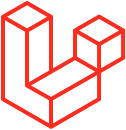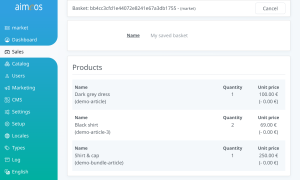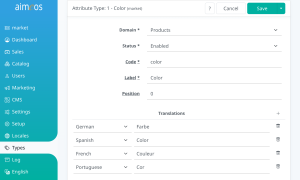
The 2023.10 version of the Aimeos e-commerce framework for Laravel and TYPO3 is available now! Especially developers will love the 2023 version because it contains a lot of simplifications and fully supports scaleable cloud setups like Kubernetes natively. The most important updates in 2023 are:
- Laravel 10 distributions
- TYPO3 12 support
- Kubernetes/Serverless support
- Create managers easily
- Merged order and order base
- Stored basket panel
- DB-based translations for type names
- VueJS and GraphQL in backend
Laravel 10 distributions
Since the Laravel 10 release in February 2023, Aimeos fully supports the latest Laravel version and since 2023.04, the Aimeos headless and full stack distribution are based on Laravel 10. You can bootstrap your own Aimeos application in less than five minutes using those distributions and get a fully working Laravel 10 application. This also includes pre-configured authentication setup for both, the full stack and the headless distribution.
TYPO3 12 support
Also, Aimeos 2023.x fully supports TYPO3 12.4 since it’s release in April. Many changes has happened in v12 compared to v11, especially a lot of deprecated code has been removed. This made it very hard to make Aimeos 2023.x available for TYPO3 v11 too so we’ve decided to support v12 only in that release. Therefore, if you need a feature from Aimeos 2023.x or want to upgrade after two years of free support, you must upgrade to the latest TYPO3 v12 too.
Kubernetes/Serverless support
We are proud to announce that Aimeos 2023+ is the first cloud-native e-commerce solution for Laravel. Everything including file imports can be distributed across any cloud environment like Kubernetes, AWS, Google Cloud, Azure or so called serverless environments now. Aimeos for Laravel is cloud-ready since the beginning and images/CSS/JS files can be stored in S3 or similar cloud storage services but files were read only from a local file system. This this year, you can store files for importing products, categories, users, etc. from any remote server regardless if they are in CSV or XML format.
We also moved our complete server infrastructure from traditional hosting to a private Kubernetes cloud beginning this year including the web sites, demo setups and private package repository.
Create managers easily
Extending existing managers is extremely simply but writing new managers for own data domains or extending existing data domains required a lot of boilerplate code in the past. Since 2023.10, creating new managers is as easy as extending managers now.
First of all, create a setup task for the database migration as before:
namespace Aimeos\Upscheme\Task;
class Test extends Base
{
public function up()
{
$this->info( 'Creating test schema', 'v' );
$this->db( 'db-test' )->table( $name, function( $table ) {
$table->engine = 'InnoDB';
$table->id()->primary( 'pk_mstes_id' );
$table->string( 'siteid' );
$table->string( 'label' )->default( '' );
$table->int( 'position' )->default( 0 );
$table->smallint( 'status' )->default( 1 );
$table->meta();
} );
}
}Then, create the manager for the new domain named “test”:
namespace Aimeos\MShop\Test\Manager;
class Standard
extends \Aimeos\MShop\Common\Manager\Base
implements \Aimeos\MShop\Common\Manager\Iface
{
public function getSaveAttributes() : array
{
return $this->createAttributes( [
'label' => [
],
'status' => [
'type' => 'int',
],
'position' => [
'type' => 'int',
'label' => 'Position for sorting'
],
] );
}
}That’s all! You can work with your new manager like with any other manager from the Aimeos core:
$manager = \Aimeos\MShop::create( $this->context(), 'test' )
$item = $manager->create()
->set( 'label', 'test label' )
->set( 'position', 2 )
->set( 'status', 1 );
$item = $manager->save( $item );
$label = $item->label;
// or using get() with default value
$label = $item->get( 'label', 'default value' );For more information, there’s an article about creating new managers in the Aimeos documentation.
Merged order and order base
The biggest architectural change since the beginning is simplifying the order data domain by merging the order and order base tables/managers/items. The initial idea behind was that we can have several invoice/refund entries for each stored order base item (=basket) but that turned out to not work well over the years and complicated handling orders a lot. Thus, the data is all stored in the order record now.
That leads to some consequences, especially for the JSON:API as this change isn’t backward compatible! An application using the JSON:API doesn’t need to use the order endpoint any more to create an order item because the basket endpoint did that already. Furthermore, the property names in the basket changed and “.base” has to be removed.
The JSON:API has been backward compatible for six years (2017-2022) and we want to keep v2 stable for the next 5-10 years now.
Stored basket panel
Customer baskets are stored in the database during some time and now, the admin backend contains a new “Sales > Baskets” Panel in the admin backend. Administrators and editors can check saved and abandoned baskets of the customers and it’s also possible to send emails to 3rd party applications for reminding customers about their abandoned carts.
DB-based translations for type names
Before, translations for attribute types were only possible by translating them statically the Gettext translation files or in the Aimeos configuration. Thus, only developers were able to update these translations and it was difficult to update translations if they have been delivered by ERP systems.
Now, type translations are saved in the database along with the types and can be edited in the admin backend and updated easily by ERP systems. This is available for all types, not only attribute types.
VueJS and GraphQL in backend
Several panels have been rewritten in the admin backend to use VueJS components now. This lead to better code quality and is another step forward to remove all jQuery-related code in the next versions. Also, VueJS components for which no VueJS 3 version is available has been replaced by better supported ones, namely the combo box select components which have been replaced by Vue Multiselect now. Finally, this will make the upgrade to VueJS 3 possible in the next versions.
Furthermore, requests to the JSON admin API has been replaced by requests to the new GraphQL API where possible. We will continue to extend the GraphQL API and replace existing JSON admin API requests until we completely phased out the JSON admin API. In 2024.x, the JSON admin API will be also marked as deprecated. The frontend JSON:API will never be replaced and will be the only way for frontends to interact with Aimeos servers as GraphQL is not suited well for read-heavy applications like e-commerce apps.





Thank you for the great package!
Is there a way to see a preview of the 3rd party themes?
Because under https://aimeos.com/extensions are only the names and prices